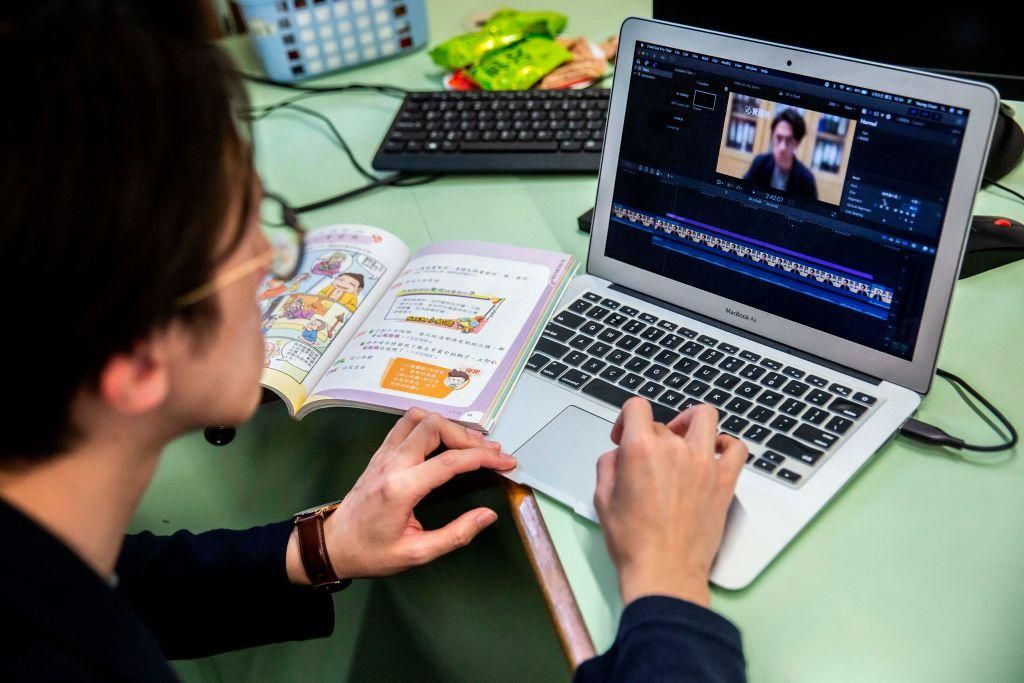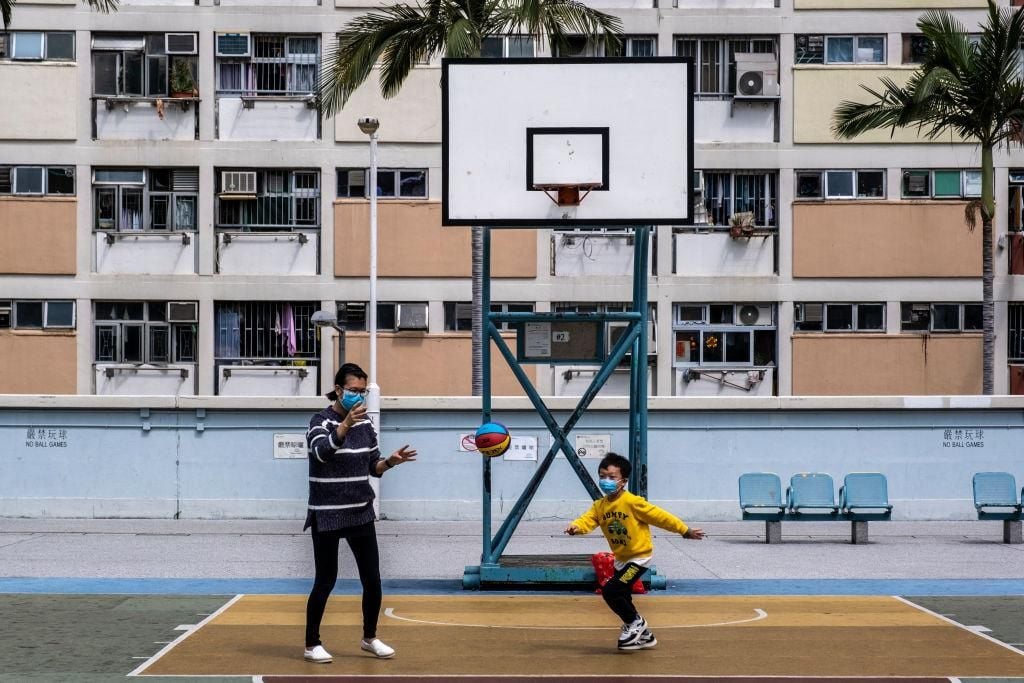What Happened When Hong Kong’s Schools Went Virtual to Combat the Spread of Coronavirus
A temporary solution during months-long school shutdowns, the online classrooms may be an experiment the rest of the world can learn from
/https://tf-cmsv2-smithsonianmag-media.s3.amazonaws.com/filer/75/89/758955c2-0b08-40d0-b3ef-92bcd2abe975/empty_hong_kong_classroom_during_coronavirus_outbreak.jpg)
In the video, my son’s preschool teacher is sitting alone in an empty classroom, surrounded by wooden toy blocks. “When I am building, do I put the small block down and then the big block?” she asks the camera. “Or do I put the big block and then the small block?”
My 3-year-old son is lounging on the couch, half watching, half flipping through a pop-up book. He’s dressed in a fleece shark costume, his preferred attire when not forced to wear his school uniform.
This is what "school" looks like these days here in Hong Kong. Because of the coronavirus outbreak, all schools, including my son's private bilingual preschool, have been closed since January, and won’t reopen until late April at the earliest. "The exact date of class resumption is subject to further assessment," announced the Education Bureau, which controls all schools in Hong Kong, public and private, on February 25. It’s all part of the “social distancing” measures the city has mandated to slow the virus’s spread, which include closing libraries, museums and recreation facilities like pools. Students from preschoolers through PhD candidates are now doing all their education online, a move the Education Bureau calls "suspending classes without suspending learning."
As coronavirus spreads across the globe, other countries are joining Hong Kong and mainland China in this massive, unplanned experiment in online learning. According to Unesco, as of Friday, 14 countries have shut schools down nationwide, affecting upwards of 290 million students, while 13 countries, including the United States, have seen localized school closings. In recent days, schools from Scarsdale, New York, to San Francisco have closed temporarily over contagion concerns. The University of Washington and Stanford University have turned to online classes for the remainder of the quarter, and others are following suit for various lengths of time. Some experts believe more widespread and long-term closures will be necessary in areas with high levels of community transmission. States are preparing for that possibility by looking at their own online learning policies.

But what does online learning involve here in Hong Kong? It depends. The city benefits from high internet penetration—90 percent of citizens over 10 years old are online. But beyond that it gets more complicated. The city has a diverse variety of schools, from free government-run schools to partially subsidized English-language schools for non-Cantonese speakers to private religious and international schools. Hong Kong has no specific online curriculum, so schools are cobbling together their own solutions using a myriad of platforms and apps, from Google Classroom, a free web service for assigning and sharing work, to BrainPOP, a site offering animated educational videos. Some students are expected to work alongside their classmates in real time. Others are allowed to watch pre-recorded videos or complete emailed worksheets at their own pace. Some parents are happy with their setups. Others have taken to Facebook to commiserate over “mommy needs wine” memes. The situation can give some insight into what Americans might expect as some schools transition to online learning.
“I’ve been working from home the past four weeks, and it’s been incredibly insightful to actually see what’s going on, because normally I’m not in school,” says Anna Adasiewicz, a business development manager originally from Poland, who has lived in Hong Kong for 16 years. Her 12-year-old daughter attends a subsidized English-language school run by the English Schools Foundation, which runs 22 schools in Hong Kong.
Unlike my son and his shark costume, Adasiewicz’s daughter is expected to be “dressed appropriately” and sit at a table, not a couch, when she logs on to Google Classroom each morning. Her school has been using the free service to share assignments, monitor progress, and let students and teachers chat. They're also doing interactive lessons via Google Hangouts Meet, a virtual-meeting software made free in the wake of the coronavirus.
“I actually think she’s more focused with this approach,” Adasiewicz says. “She’s not distracted by other kids. The class sizes are normally about 30, so I imagine a typical teacher spends a good portion of the time on behavior management. Here the teacher can mute anyone!”
Cat Lao, a special education classroom assistant, whose daughters are 3, 6 and 8, has also been happy with the experience. Her youngest daughter is in a local preschool while her older two attend an English Schools Foundation primary school. Her middle daughter has been using the Seesaw app to share assignments with her teacher and receive feedback. Her eldest daughter has been using Google Classroom and Flipgrid, an app that lets teachers set topics or questions for students to respond to via video. This child especially appreciates the real-time Google Meets, Lao says, since she misses the social aspects of school.
“They’re still learning, and still part of their community as much as they can be,” she says.
But many parents are not happy to find themselves working as de facto part-time teachers.
“For parents who have to work from home, managing school can be quite a task,” says Pragati Mor, a teacher and mother of two young daughters who attend the French International School of Hong Kong.
Her children’s online learning program has been full of technological glitches, Mor says, which requires taking time from her own workday to fuss with unfamiliar programs.
“It needs adult supervision,” she says. “It can be quite daunting.”
Susan Bridges, an education professor at the University of Hong Kong who studies online learning, admits, “It’s a challenge; lots of parents are having to adjust their lifestyles to what feels like homeschooling.”
Research shows that it’s more difficult to keep students motivated online, which means teachers need to mix up their strategies, Bridges says. This can include making lectures shorter, and incorporating real-time quizzes and online small group work. Another problem is testing. If a teacher had planned a proctored exam, they may need to switch to an unsupervised type of assessment instead, such as a term paper. Then there’s the question of hands-on learning, which is especially important in some higher education fields, such as medicine or speech pathology.
“All of that field work that’s essential for our professional and clinical programs, all of these are very difficult to replace, so that’s a big challenge,” Bridges says.
Charles Baker, the owner of an English-language tutoring center in Hong Kong’s New Territories district, has had to think outside the box to make online learning successful. Before coronavirus hit, he’d already begun using a virtual classroom platform called WizIQ to connect his students with classrooms in Southeast Asia, as a sort of online exchange program. This put him in a better position than many to jump directly to online learning, he says. The main challenge is keeping young children engaged without the physical presence of a teacher. To deal with this, he’s shortened class lengths from an hour to 30 minutes for his 5- and 6-year-old students.
“I think this situation is a really great opportunity for people to be utilizing technology in a more fundamental kind of way,” he says.
Successful online learning is all about “engagement and interaction,” Bridges says. The University of Hong Kong has been helping its professors create more dynamic online learning environments using video meeting platforms like Zoom and recording technology like Panopto, which make it possible to insert quizzes, PowerPoints and captions into pre-recorded lectures. Beyond that, class formats have been up to the individual professors.
But, as Bridges points out, privacy and space are major concerns. Professors are discovering that students won’t turn on their video cameras because they’re embarrassed to be sitting in their childhood bedrooms in front of old K-Pop posters. Zoom has a solution for this, as Bridges demonstrates to me. She turns on a digital background and suddenly she appears to be in a sunny, minimalist office, a potted plant on the desk behind her. Other than a slight pixilation of her face, it looks pretty real.
“These are just little fix-its,” she says.
Still, a digital background can’t change the stresses of multiple people learning and working in Hong Kong’s notoriously tiny apartments.
“It’s crowded, it’s complicated, there are demands on technology,” says Adasiewicz, whose husband, a lawyer, has also been working from home. “We had to update our router.”

Childcare is a major issue as well. Many Hong Kongers are now returning to their offices after an extended period of working remotely, leaving children at home in front of screens. Some rely on their nannies—nearly half of Hong Kong families with children and a working mother employ a live-in “foreign domestic helper,” usually from the Philippines or Indonesia. Other families count on grandparents for childcare, which means elderly caregivers who may not speak English must serve as tech support.
And not all classes lend themselves to online education. It’s hard to teach physical education online, and missing out on exercise is a problem not only for obesity rates but also for vision. Hong Kong has one of the highest rates of myopia (near-sightedness) in the world, with some 70 percent of kids over 12 suffering, and experts believe it’s because children spend too much time indoors looking at close objects like books and tablets. For many kids, who live in crowded housing estates with little green space, schools’ tracks and rooftop basketball courts provide some of the few opportunities they have for outdoor play. Some schools are encouraging students to take frequent breaks to do mini-exercises like a minute of jumping jacks.
Many hope this experience will force Hong Kong schools to professionalize and standardize their online curricula. This could potentially provide a template for other cities and countries facing their own coronavirus school shutdowns.
“Could this crisis inspire the bureau [of education] to incorporate online learning into the official curriculum and take Hong Kong education to the next level?” wondered Chak Fu Lam, a professor of management at the City University of Hong Kong, in a letter to the editor of the South China Morning Post.
At the end of the day, most parents and teachers seem to understand the situation is out of their control, and that everyone is doing the best they can.
“We have to embrace technology,” Adasiewicz says. “It’s coming our way whether we like it or not.”
Unfortunately, it seems, so is coronavirus.
/https://tf-cmsv2-smithsonianmag-media.s3.amazonaws.com/accounts/headshot/matchar.png)
/https://tf-cmsv2-smithsonianmag-media.s3.amazonaws.com/accounts/headshot/matchar.png)